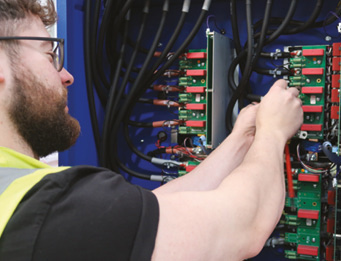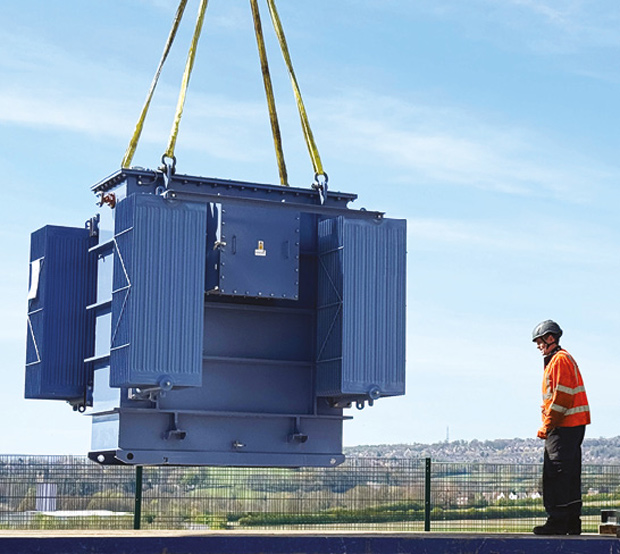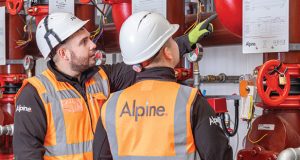 Outdated energy infrastructure could mean organisations are not getting the savings offered by modern alternatives. Alexandra Kuncewicz, Business Development Manager from Powerstar explains why
Outdated energy infrastructure could mean organisations are not getting the savings offered by modern alternatives. Alexandra Kuncewicz, Business Development Manager from Powerstar explains why
The UK still has an ambitious net zero target of 2050, and many industry bodies have even more stringent targets. The British Retail Consortium, for example, has put 2040 as the deadline for Net Zero retail. Measurably improved energy efficiency can lead to cost-savings by reducing emissions, which lowers energy use and results in energy savings. But when comparing existing assets with more modern alternatives there are many cost and sustainability differences.
THE PITFALLS OF OLDER TRANSFORMERS
Transformers are a common asset across multiple industries and organisations and operate by stepping up or stepping down incoming voltage to the level required on-site. However, the UK’s fleet averages 60 years old, despite the fact we now estimate the operational lifespan of a transformer to be just 20 years. While your transformer may still be working, it is more likely to fail, leading to unplanned, expensive emergency maintenance, downtime and reputational damage. Alongside this, with decarbonisation and cost-effectiveness paramount, an inefficient transformer leads to unnecessary emissions, by inflating Scope 2 emissions and unnecessary energy spend.
MODERN TRANSFORMER SAVINGS
Rather than relying on your old transformer not failing before its next scheduled maintenance, there is the option of replacing it with a modern, ‘low-loss’ transformer, an approach that offers the advantage of lowering costs and reducing emissions. Compared to the standard CRGO (Cold-Rolled Grain-Oriented) type of transformer, those which use modern amorphous core technology can reduce core losses by up to 70 per cent. Where integrated remote monitoring is also incorporated, the device can offer real-time insights into transformer performance, enabling you to make efficiency improvements where needed.
A site survey that includes voltage profile measurements can help identify where a transformer replacement could improve sustainability and reduce energy spend. In one example engineers were asked to advise on a 38,000 square foot manufacturing site to help reduce energy consumption. The survey indicated poor performance in the existing transformer. Replacement with a super low-loss amorphous core transformer with dynamic voltage optimisation significantly reduced losses, bringing about cost savings while regulating the incoming power supply. This equates to savings of more than 107 kWh per annum, reducing energy consumption by 9.5 per cent and carbon emissions by approximately 60 tonnes.
DYNAMIC VOLTAGE OPTIMISATION
Where the National Grid supplies an average operating voltage of 248V, most UK electrical equipment has a standard operating voltage of 220V. Overvoltage wastes energy and puts equipment under unnecessary stress, which can shorten its lifespan and mean unnecessary maintenance costs. Voltage Optimisation (VO) stabilises incoming voltage to match the optimal level for on-site electrical equipment. Unnecessary voltage is returned to the grid – helping to take pressure off the network.
This is why alongside transformers, many organisations are also considering investing in VO within their energy management infrastructure. Upgrading an older fixed VO system to a modern, dynamic VO can improve efficiency, reduce energy costs and lower carbon emissions.
As the UK becomes increasingly electrified and businesses incorporate more smart technologies, conditioning incoming voltage by using devices like power conditioners or voltage regulators to stabilise and protect equipment from fluctuations in the power supply can improve site resilience, since even minor spikes or sags can cause equipment to trip or shut down. Though often brief, such disruptions can create significant delays in achieving normal operations again, through lengthy restart processes. The increased digitisation of many business operations heightens the risk of sudden shutdowns, which can result in the loss or corruption of vital data.
 Modern, dynamic VO can offer real-time voltage management, while remote monitoring allows for site consumption to be logged, providing real-time performance data to enhance resource efficiency. This ensures that savings are transparent and logged, are easy to access and track, to help facilities managers make more informed decisions regarding energy management.
Modern, dynamic VO can offer real-time voltage management, while remote monitoring allows for site consumption to be logged, providing real-time performance data to enhance resource efficiency. This ensures that savings are transparent and logged, are easy to access and track, to help facilities managers make more informed decisions regarding energy management.
MODERN VO IN ACTION
Energy costs, combined with ESG strategies, make improved efficiency a priority across most sectors. This was true for one of the UK’s largest food and clothing retailers, whose diverse estate – comprising hundreds of stores across the country, each with its own electrical profile and load characteristics – required an approach to VO that was both scalable and tailored to each unique site. After installing more than 200 bespoke VO systems, the annual energy and carbon savings across the entire estate averaged 6.5 per cent. These savings on energy spend and usage complement the company’s strategic ESG imperatives.
Where large losses are identified, a modern amorphous core transformer can result in huge savings, which in the case of one client was 44 per cent, resulting in asset payback of less than three years. With VO, energy bills are generally reduced by between 5-8 per cent depending on the site profile, which can mean an average return on investment of between 12 and 30 months.
Ultimately, the benefits of replacing old assets with modern alternatives will depend on each site’s profile and energy demands. But the case for exploring upgrades and replacement is compelling.





